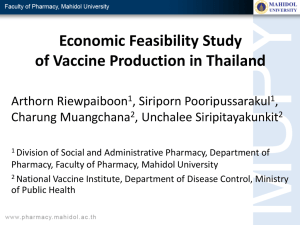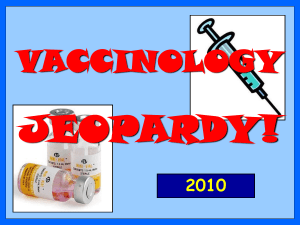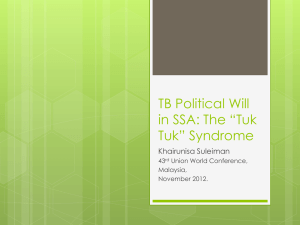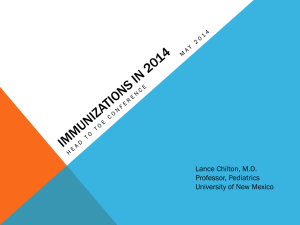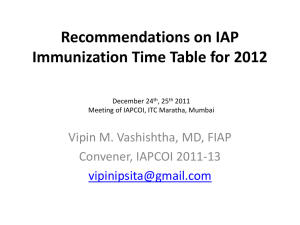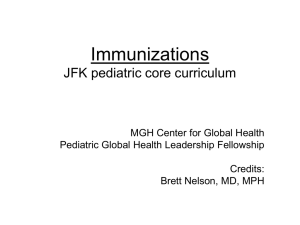Vaccine Hesitancy Presentation
advertisement
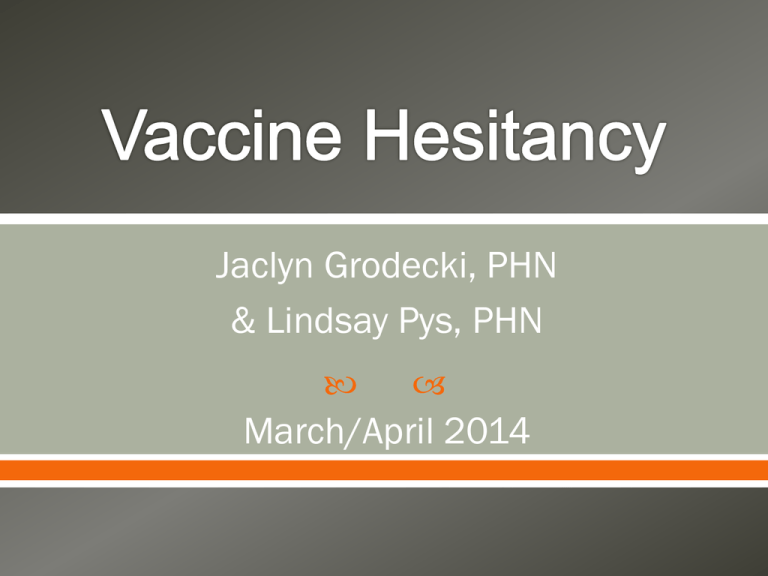
Jaclyn Grodecki, PHN & Lindsay Pys, PHN March/April 2014 Welcome & introductions Define vaccine hesitancy Review historical context of immunizations including morbidity & mortality rates of diseases Discuss where the recent vaccine controversies have come from and how they are unfounded Learn how to dispel vaccine myths regarding Autism, additives (thymerosal, formaldehyde etc), 3 vaccine "needle overload“, and natural immunity Understand how to discuss vaccines more effectively with parents Talk about process for families who will not immunize “Vaccine hesitancy is a term used to describe refusal or delay in regular immunization schedules due to concerns about immunization“ (PHAC, 2013). lack of information about vaccines lack of appreciation of the severity and incidence of vaccine-preventable diseases conflicting information mistrust of the source of information perceived risk of serious adverse events and concerns regarding injections sociocultural beliefs (e.g. religious beliefs) (PHAC, 2013) The internet has changed the environment around immunization The public is increasingly questioning recommendations of experts and public institutions on the basis of their own, often web-based research. The majority of such individuals are not against immunization, but are seeking answers to questions about vaccine safety, immunization schedules, changing policies, and the relevance of some vaccines. In general, events that are unfamiliar, involve a man-made process, involve loss of control, are mandatory, or involve a decision to do something rather than avoid something, are perceived as risky. Assess the level and type of information that an individual wants and adapt the information provided accordingly; for example, some people will appreciate scientific evidence while others will prefer anecdotal information and stories from personal experience. (PHAC, 2013) Present evidence in an understandable way; for example, concepts such as single event probability or relative risk may not be understandable for most vaccine recipients or parents; scientific jargon and acronyms should be avoided. (PHAC, 2013) Frame immunization in terms of positive gains o “A vaccine is 99% safe” is more effective than, “There is a 1% chance of side effects.” o “If you decide not to get the vaccine, you increase your chances of getting a disease,” is more effective than, “If you decide to get the vaccine, you decrease your chances of getting or transmitting a disease.” (PHAC, 2013) Use and have available varied information formats (visual, audio, printed material, websites), tailored to a range of socio-cultural groups (i.e., educational level, language, ethnic and cultural background). (PHAC, 2013) In order to have a productive conversations with parents- assess which aspect(s) of the vaccine is the barrier to immunizing (e.g. needing info is going to be a much different conversation than religious beliefs) “Vaccine hesitancy is a term used to describe refusal or delay in regular immunization schedules due to concerns about immunization“ (PHAC, 2013). lack of information about vaccines lack of appreciation of the severity and incidence of vaccinepreventable diseases conflicting information mistrust of the source of information perceived risk of serious adverse events and concerns regarding injections sociocultural beliefs (e.g. religious beliefs) (PHAC, 2013) How vaccines work How vaccines are tested & approved Timing of vaccines http://www.simcoemuskokahealth.org/topics/immunizatio n/ImmunizationInformation/howvaccineswork.aspx Prior to use in Canada, vaccines are extensively tested and the manufacturer must submit scientific and clinical evidence that demonstrates the safety and efficacy of the vaccine. Health Canada supervises all aspects of vaccine production by manufacturers to ensure safety, efficacy and quality. Vaccine safety continues to be rigorously monitored and evaluated after the vaccine is on the market. Even after a vaccine has been authorized for marketing in Canada, every batch is laboratory tested for safety and quality. Canada has a comprehensive vaccine safety monitoring system which helps to alert public health authorities to trends in reported adverse events or any unusual adverse events not previously reported so that appropriate action can be taken should such a concern arise. “Myth: Giving a child more than one vaccine at a time can increase the risk of harmful side-effects, which can overload the child’s immune system. Scientific evidence shows that giving several vaccines at the same time has no adverse effect on a child’s immune system. Children are exposed to several hundred foreign substances that trigger an immune response every day. The simple act of eating food introduces new antigens into the body, and numerous bacteria live in the mouth and nose. A child is exposed to far more antigens from a common cold or sore throat than they are from vaccines. Key advantages of having several vaccines at once is fewer clinic visits, which saves time and money, and children are more likely to complete the recommended vaccinations on schedule. Also, when it is possible to have a combined vaccination, e.g. for measles, mumps and rubella, that means fewer injections.” (WHO, 2013) “Current data suggest that the theoretical capacity determined by diversity of antibody variable gene regions would allow for as many as 109 to 1011 different antibody specificities” “If each vaccine contains approximately 100 antigens…then each infant would have the theoretical capacity to respond to about 10 000 vaccines at any one time” “Of course, most vaccines contain far fewer than 100 antigens (for example, the hepatitis B, diphtheria, and tetanus vaccines each contain 1 antigen), so the estimated number of vaccines to which a child could respond is conservative.” “But using this estimate, we would predict that if 11 vaccines were given to infants at one time, then about 0.1% of the immune system would be “used up.”” http://pediatrics.aappublications.org/content/109/1/124.full “Vaccine hesitancy is a term used to describe refusal or delay in regular immunization schedules due to concerns about immunization“ lack of information about vaccines lack of appreciation of the severity and incidence of vaccine-preventable diseases conflicting information mistrust of the source of information perceived risk of serious adverse events and concerns regarding injections sociocultural beliefs (e.g. religious beliefs) (PHAC, 2013) Rates of diseases (morbidity & mortality) Change in rates due to vaccine Symptoms of diseases Incidence table http://www.phac-aspc.gc.ca/publicat/ciggci/p01-02-eng.php#tab1 Map http://www.npr.org/blogs/health/2014/01 /25/265750719/how-vaccine-fears-fueledthe-resurgence-of-preventable-diseases “Vaccine hesitancy is a term used to describe refusal or delay in regular immunization schedules due to concerns about immunization“ lack of information about vaccines lack of appreciation of the severity and incidence of vaccinepreventable diseases conflicting information mistrust of the source of information perceived risk of serious adverse events and concerns regarding injections sociocultural beliefs (e.g. religious beliefs) (PHAC, 2013) Some of the below professionals do not believe in vaccination but it seems to be person dependent Chiropractors http://www.drbarryyoung.com/article/1572.html Naturopaths http://www.healthwatcher.net/quackerywatch /Naturopathy/tstar000709-Lisa-Doran.html “Vaccine hesitancy is a term used to describe refusal or delay in regular immunization schedules due to concerns about immunization“ lack of information about vaccines lack of appreciation of the severity and incidence of vaccinepreventable diseases conflicting information perceived risk of serious adverse events and concerns regarding injections mistrust of the source of information sociocultural beliefs (e.g. religious beliefs) (PHAC, 2013) Represent the risks and benefits of vaccines fairly and openly. anticipation of pain and anxiety associated with the needle coincidental rather than causal adverse events that are perceived as vaccine-related (autism) components of vaccine (formaldehyde, thymerosol etc) risk of vaccine causing disease like symptoms actual vaccine side effects (or adverse events) -Common side effects: low fever, sore red spot, small swelling at the site, irritability or drowsiness -Additional side effects vary in severity and dependent on type of vaccine. Pain relief options (acetaminophen, breastfeeding, sugar water, distraction – bubbles, toys) Coincidental discussion will depend on parental concerns; for example discuss incidence of normal childhood illnesses (fever, fussiness, rash), discuss timing of MMR with speech eruption / early autism signs Components of vaccine - see handout Vaccines can cause disease-like symptoms - although live attenuated vaccines replicate, they usually do not cause disease such as may occur with the “wild” form of the organism. When a live attenuated vaccine does cause “disease,” it is usually much milder than the natural disease and is referred to as an adverse reaction. Be open and honest about possible side effects of vaccines. Use positive phrasing such as “vaccines are 99% safe” as opposed to “there is a 1% chance of adverse reactions”. Compare side effects with symptoms of contracting the disease “Vaccine hesitancy is a term used to describe refusal or delay in regular immunization schedules due to concerns about immunization“ lack of information about vaccines lack of appreciation of the severity and incidence of vaccinepreventable diseases conflicting information perceived risk of serious adverse events and concerns regarding injections mistrust of the source of information sociocultural beliefs (e.g. religious beliefs) (PHAC, 2013) Mistrust of the source of information (e.g., perceptions of business and financial motives of the vaccine industry) Personal perceptions and the trust in individuals and institutions that produce, legislate, and deliver vaccines There are a number of factors that affect the extent to which an individual is trusted: perceptions of knowledge and expertise, openness and honesty, and concern and caring. Health care providers are perceived as trusted individuals and have a vital role in ensuring continued success of immunization programs and in maintaining confidence in the effectiveness and safety of vaccines. PHAC, 2013 “Vaccine hesitancy is a term used to describe refusal or delay in regular immunization schedules due to concerns about immunization“ lack of information about vaccines lack of appreciation of the severity and incidence of vaccinepreventable diseases conflicting information perceived risk of serious adverse events and concerns regarding injections mistrust of the source of information sociocultural beliefs (e.g. religious beliefs) (PHAC, 2013) There are certain religious individuals (e.g. within the Catholic, Amish, Muslim or Christian Scientist religions) who are morally opposed to vaccinations. Please be respectful of these religious beliefs. For those who are morally opposed to vaccines, or those parents who refuse immunization (despite HCP best efforts), it would not be in the best interest of the child to consider releasing the family from your care. Parents who choose not to vaccinate must complete a legal statement. This form must be notarized. These forms must be brought to Public Health Services. Effective treatments do not exist for many vaccine preventable diseases Pre-vaccination screening exists to help prevent adverse reactions Those who receive vaccines are monitored post vaccine for signs and symptoms; doctor offices are trained to manage adverse reactions (eg: anaphylaxis) Herd immunity will protect those unable to receive the vaccination- parents should not rely on this (e.g. tetanus) an unvaccinated child could infect others Re-emergence of vaccine preventable diseases reappear quickly once immunization rates begin to decrease (eg: mumps and measles) Do you want your child to have the same health advantages that you had? http://www.who.int/features/qa/84/en/ http://www.phac-aspc.gc.ca/publicat/cig-gci/p01-04-eng.php http://www.cps.ca/documents/position/working-with-vaccine-hesitant-parents http://www.hamilton.ca/HealthandSocialServices/PublicHealth/Immunization/ HANDOUTS -Incidence of select vaccine preventable diseases in Canada -Statement of conscience or religious belief -Statement of medical exemption -PHO adverse events 2012 -Vaccines may contain additional substances to ensure effectiveness and safety -Common side effects of diseases and vaccines -Vaccine schedule for Ontario -Minimum dose intervals for vaccines -FAQ for Health Care providers.

